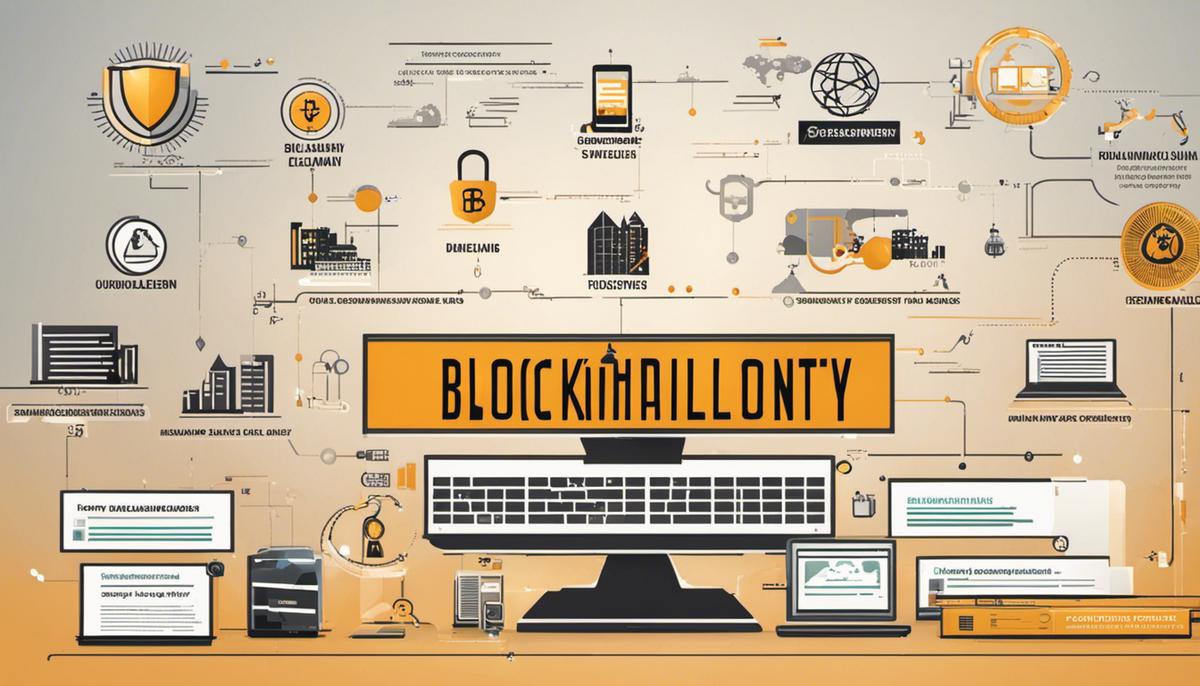Two key areas emerge at the intersection of technology and security: blockchain and cybersecurity. The development and implementation of blockchain technology signifies a paradigm shift in the way transactions are conducted and recorded. This revolution is not just loaded with opportunities but also fraught with challenges. With a decentralized nature and intricate cryptographic measures, blockchain technology has a profound impact on cybersecurity, particularly in securing digital transactions. However, it’s also true that this new territory comes with its own set of vulnerabilities that need to be addressed and mitigated. The ensuing sections will present a comprehensive exploration of the fundamental principles of blockchain, the security advantages it brings to the digital world, its underpinning risks, and future prospects in cybersecurity.
Concepts and Principles of Blockchain
The Fundamental Principles Underpinning Blockchain Technology: An Academic Examination
Blockchain technology stands as a revolutionary innovation, unaffecting not only the realm of computer science but also banking, supply chain management, healthcare, and governments worldwide. Underneath this impactful novel technology lie primary principles upon which this juggernaut of data validation and storage thrives: decentralization, transparency, immutability, and security.
-
- Decentralization: The Democracy of Data
The democratization of data, otherwise termed decentralization, illuminates the foremost key principle giving the blockchain its unique character. Conventionally, data or money transfer is guided through centralized authorities like banks or payment apps, effectively functioning as intermediaries. Blockchain technology, however, disdains this hierarchical authority. Through the advent of a peer-to-peer network where every participant equally shares the authority, blockchain extenuates the role of intermediaries, bestows power to individuals, and facilitates direct interaction between parties.
-
- Transparency: The Jewel of the Blockchain
Transparency – an oft-praised feature of blockchain technology, ensures that every transaction is open for verified users to inspect while still sustaining anonymity. Each participant or ‘node’ within the blockchain can access the entire history of transactions, yet the identities of the individuals behind the transactions are encrypted. By offering such an unparalleled level of transparency, blockchain technology fosters an environment of trust and accountability that is seldom seen in traditional models of transactional systems.
-
- Immutability: The Garuda of Data Integrity
Immutability serves as another gem in the cornucopia of blockchain’s qualities. Once a transaction is embedded within a blockchain, it is nearly impossible to alter or delete. This immutability is the result of the cryptographic hash function, a complex mathematical algorithm which seals each data block. The principle of immutability fundamentally preserves data integrity and openly discourages fraudulent activities, thereby reinforcing trust in the system.
-
- Security: The Guardian of the Blockchain
Finally, we delve into the principle of security, the most outstanding fortress of blockchain technology. Each transaction in a blockchain undergoes validation through a collective consensus mechanism, like proof-of-work or proof-of-stake. After a transaction is validated, it is encrypted and linked to the previous transaction, fortifying the network to a level impervious to hacks and attacks. This scheme of cryptographically secured transactions and consensus-driven validation propels blockchain technology to an echelon of highly secured platforms.
These described principles – decentralization, transparency, immutability, and security, are like four pillars supporting the sophisticated framework of blockchain technology. Each of these principles interacts, overlaps, and synergizes with the others, entwining to create a system of exceptional trust, unmatched security, and prolific potential. Thus, that variegated tapestry referred to as blockchain casts its reassuring shade over a world increasingly dependent on digital transactions and data storage, predicting an innovative, decentralized, and secure future for global systems.

Securing Digital Transactions
Blockchain technology, emblematic of the digital age, represents an innovative solution to recording digital transactions in a secure manner. The crypto-economic protocol that underpins the security aspects of blockchain technology is integral to preserving this security and enhancing the integrity of the transactional process.
The cryptographic nature of blockchain technology disallows nefarious activities and ensures the safety of digital transactions. Through encryption, every piece of data committed to the blockchain is transformed into a unique cryptographic signature or hash. These hashes are virtually indecipherable unless the correct cryptographic key is applied to interpret the data. With each transaction assigned a distinct hash, alterations are immediately noticeable and sever an immutable link in the blockchain, thus foiling the effort of potential security breaches.
Further enhancing the security of digital transactions is the principle of distribution. In comparison to traditional methods where a centralized authority holds all power, the blockchain adopts a distributed ledger approach. Copies of the entire ledger are stored on numerous computer servers globally, known as nodes. When a transaction occurs, it is transmitted to all nodes in the network, validated, and then recorded on the blockchain. The power is shifted away from a single authority to a collective of individuals, rendering it nearly impossible for cybercriminals to compromise a majority of nodes swiftly enough to alter transaction data.
An underlying merit of blockchain technology often overlooked is the deterrence of double spending, a major challenge associated with digital currency. Double spending pertains to the same digital token being expended more than once. Blockchain addresses this issue by reinforcing the transactional process with a verification mechanism. Any attempt to double-spend would require altering all subsequent transactions recorded in the blockchain, which is essentially impracticable.
Trust is also intrinsically built into the blockchain infrastructure. Through the mining process, blocks of transactions are verified by nodes in the peer-to-peer network. Nodes competing to add the next block in the blockchain must solve complex mathematical problems, a process known as proof-of-work. The rigor of this systemic process ensures the fidelity of all transactions committed to the blockchain.
Finally, the versatility of the blockchain allows for the addition of smart contracts. These self-executing contracts embedded with predefined rules and regulations automatically administer transactions once criteria are met, essentially eliminating the need for intermediaries. By foreclosing the opportunities for fraudulent manipulation and human error, these innovation-hosting platforms amplify the security of the digital transaction landscapes.
In conclusion, blockchain technology not only revolutionizes the commerce of the digital world but also reinstates a sense of trust and safety. By utilizing cryptographic principles, leveraging the strength of a distributed network, preventing double spending, and incorporating inviolable contracts, the blockchain demystifies the complexities of digital transactions and ushers in a new era of secure digital commerce.

Blockchain Vulnerabilities
The commendable virtues of blockchain technology notwithstanding, a scientific inquiry into the vulnerabilities and potential risks inherent in these systems is not only relevant but imperative. Information is just as potent when it reveals weakness as when it highlights strength.
The most notable vulnerability in blockchain technology is its susceptibility to a ‘51% attack’ on proof-of-work consensuses. This is a risk scenario where a single entity gains more than 50% control of a network’s mining hash rate, thereby possessing an inordinate power to manipulate transaction validation in the entire network. This type of attack is a glaring paradox in a system that is predicated on decentralization.
Blockchain systems also exhibit vulnerability in the realm of privacy. Although transactions are transparent to all users, anonymity may not always be guaranteed. The pseudo-anonymous nature of these systems allows for the tracing of transactions back to the initiators, creating a potential privacy issue. Moreover, one cannot ignore the ‘dusting attack’ risk, where cybercriminals send a small amount of cryptocurrency to a wallet–the dust–to break the privacy of the wallet holder by tracking their transactions.
Furthering exploration into the realm of smart contracts, they appear as a double-edged sword within the blockchain context. On one end, they provide a framework for autonomous and trustless transactions between parties, flourishing as programmable, self-executing contracts with the terms of the agreement directly written into the code. On the other end, smart contracts bring their own vulnerability in form of flawed contract codes, which malignant actors can exploit to release funds inappropriately or freeze them indefinitely.
Moreover, one must consider potential risks in scalability. The absence of capacity to hold a massive number of transactions significantly limits the utility of blockchain systems. Despite their robust nature, current blockchains are not designed to process multiple transactions in seconds, as compared with traditional digital systems. This could act as a potential roadblock in the widespread adoption of blockchain technology.
Lastly, there is a potential risk in the over-dependence on cryptographic systems for security. Cryptographic algorithms, though seemingly invincible today, could become vulnerable tomorrow with advancements in quantum computing. As quantum computers get closer to becoming a reality, blockchain faces the risk of cryptographic obsolescence, as these machines could potentially shatter the existing cryptographic measures.
While the nobility of the quest for blockchain perfection continues, it is important to shed light on its potential vulnerabilities and risks. Identifying these inherent weaknesses provides a roadmap for future blockchain development, influencing informed decision-making, strategic implementation, and the development of potential countermeasures. Recognizing and addressing these risks will foster a solid foundation for the next generation of blockchain systems.

Future of Blockchain in Cybersecurity
Forging ahead to the frontiers of knowledge on the application of blockchain in cybersecurity, several prospects reside on the horizon that offer promising advancement and potential challenges. The intersection of these two formidable fronts will undoubtedly catalyze a new era of digital protection and privacy.
One anticipatory prospect is the burgeoning field of Decentralized Identity (DID). Synchronizing the principles of decentralization and privacy innate to the blockchain, DID envisages a future where individual identities are not centrally controlled but privately owned. By distributing the power of identity verification across multiple nodes, the risk of centralized data breaches is significantly curtailed. Supporting self-sovereign identity management can reinforce the autonomy and security of individual data.
Moreover, Zero-Knowledge Proofs (ZKP) hold immense potential in the lighting pathway of cybersecurity. Equipped with imported cryptography from the heartlands of blockchain technology, ZKP can validate the veracity of information without revealing the data itself. Such a technique can bolster privacy concerns while maintaining the necessary transparency in transactions, a progressive stance against the ubiquitous ‘see-all’ internet scopes.
However, along with the sunrise of promising prospects, several clouds hover that need to be meticulously addressed. The theoretical prospect of a quantum leap in computing technology poses quite an uncertainty for the future of blockchain security. Quantum computers, with their phenomenal processing power, could pose a threat to the very cryptographic foundations embedded in the blockchain. However, the research community is already formulating post-quantum cryptographic methods to address this potential challenge preemptively.
Furthermore, energy consumption in blockchain, particularly in proof-of-work (PoW) models, casts questions on the sustainability of the technology. The exigency of energy-efficient consensus mechanisms is pressing, and future applications of blockchain in cybersecurity must address these environmental concerns.
Lastly, blockchain interoperability emerges as a potential challenge. The ability of disparate blockchain systems to interact seamlessly is paramount for a unified and robust cybersecurity framework. Hence, looking forward, blockchain standards and interoperability factors need to be factored that encourage broad-based adoption.
The interrelation of blockchain and cybersecurity is a complex, multi-dimensional domain marked by a blend of promising prospects and substantial challenges. As researchers, developers, and enthusiasts delve deeper into the labyrinthine gorges of these technologies, evolving paradigms will likely unlock new knowledge corridors and uncharted digital territories to explore.

As we embark on this blockchain journey, an important understanding to carry forward is about the potential this technology holds to revolutionize our digital infrastructure, especially from a cybersecurity perspective. However, it’s equally crucial to remain cognizant of the associated vulnerabilities that could impede its progress. Assessing these threats and developing robust countermeasures would be instrumental in harnessing the real potential of blockchain. The future of blockchain in cybersecurity seems promising, with an array of applications and growing interest across industries. Yet, until we can holistically address and nullify its inherent security threats, its universal adoption may remain a mirage. It is therefore most beneficial to us to stay continually informed and cautious, thus ensuring we remain resilient in the face of this rapid technological change.